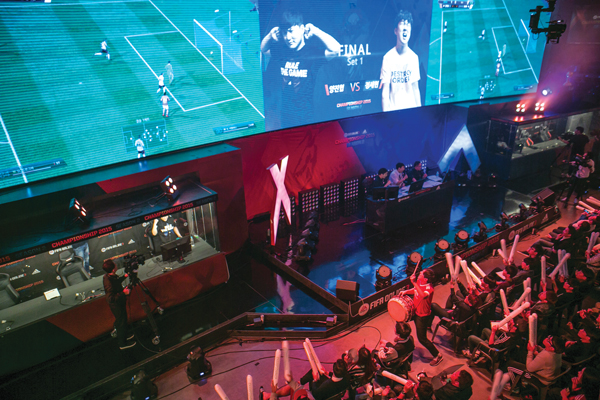T he Yankees, Patriots, Heat and Trail Blazers buying into pro esports teams? Yup.
Video games in the 2024 Olympics? Hard to believe but esports is on the program for the upcoming Asian Games so the IOC and Tokyo 2020 won’t lag too far behind.
Varsity esports teams and college scholarships for gamers? Already happening at places like Utah and Robert Morris … with more schools signing on every day.
Billions of hours played per month, millions in prize money and fat endorsement deals?
Check! You can look the facts up online (which means it must be true).
Tens of thousands of live-event spectators in big-time stadiums like Madison Square Garden in New York or the Staples Center in Los Angeles?
Check! And those events sell out in minutes.
Live television or streaming coverage of video game competition or tournaments?
Check! Happens every Friday night on TBS. Or daily on Twitch.
But is esports just a fringe idea played mostly by the Next Gen gang and almost exclusively by men? Is it a passing fad like Hula hoops, Chia Pets and the dot-com craze?
We don’t think so.
Industry reports estimate nearly a half-billion viewers globally, including notable proportions of females, high-income earners and individuals over 35.
Esports are exploding on every imaginable platform and happening in more places than most readers might imagine including dorm rooms, classrooms, showrooms and living rooms. In fact, one of us just watched CBS’s “Amazing Race” send contestants to South Korea where the show’s producers forced four teams to play video games in order to advance to the final episode.
But why is this happening?
And how come so many industry execs are still resisting this revolution? Well, based on our ongoing investigation, we think there are three easy reasons (or responses) why industry old-timers have been slow to embrace the joystick.
■ It’s not sport. Gamers just sit around their basements wearing bedroom slippers jabbing their fingers at buttons.
■ It’s not athletic. Hand-eye coordination with flat-screen technology is not worthy of comparison to hitting a 95-mile-an-hour slider that is up and in.
■ The whole thing is just stupid and young people should go outside and play catch.
That may sound harsh but ask around and it won’t take long to get answers approximating those put-downs.
We also think there are three core drivers moving under more than a few radars.
 |
Enthusiastic fans cheer at an EA Sports FIFA Online Championship in Seoul, South Korea.
Photo by: GETTY IMAGES
|
First, esports is attracting investor interest and some of the financing is non-traditional. Holding companies (Amazon, Alibaba, Google, Disney, Sony, Microsoft), pro leagues (the NBA), college conferences (the Big Ten), clubs (Man City, West Ham, Ajax), sponsors (Coke, Pepsi, Red Bull, Nissan, Papa John’s), speculators and more are intrigued by the cash potential esports activity is generating.
Although numbers are modest so far (though growing rapidly), esports has high affinity in the hard-to-reach millennial and Gen Y and Z populations. It also has the ability to create instant celebrity athletes and professional teams thus giving non-billionaires an entry point into pro sports. On top of that, favorable ROIs are predicted for the coming months and years.
Secondly, esports are globally “sticky” and not reliant on terrestrial TV or cable (hardly). In an era of cable cutting and a la carte consumption of content, the “stickiness” of video games for some attractive (and heavily targeted) members of the global population is rare and is something that could be monetized significantly as our sport media landscape changes.
There is also an interesting statistic from Newzoo indicating 40 percent of esport spectators (live or via electronic presentation from parties like Twitch and YouTube Gaming) do not play video games. Just like most NFL fans never played organized football.
Finally, for established sport properties, the possibilities of AR/VR brand extensions (Madden, FIFA, NBA 2K, etc.) and sponsor integration are particularly enticing.
Imagine Manchester United fans following their team and favorite players, engaging with fellow followers via fan clubs or social media and suddenly managing a Man U esports league or entering a Man U esports league run by active or retired Man U players.
Next, add in a fantasy component or virtual reality and suddenly Manchester United, Bayern Munich or Real Madrid (massive global brands) have boots on the ground worldwide. Perhaps now, Manchester United cafes or heavily decorated bedrooms will become actual stadiums for contestants, spectators and sponsors.
Perhaps it is another sign of the coming apocalypse.
Not prepared to accept our dystopian future? Still filled with doubt?
Try this: Riot Games’ League of Legends currently has peak concurrent players of 3 million! Translation? That means for a game that is free to play (but has already generated more than $1 billion of in-game purchase revenue), on a normal day in October, at any given hour, more than three million unique players from around the globe will be simultaneously playing LoL and racking up massive in-game hours doing so.
We could further bombard you with statistics but why bother? As a cutting-edge sport industrialist you are already determining whether your organization is suited for this new frontier and doing something about it.
On the other hand, if you’ve already dismissed this column as the work of lunatics, we salute your confidence and all-knowing steely gaze. Leave the esports revolution to the gamers.
In the meantime, keep listening to the folks who suggested TV was a bad idea. Perhaps someday soon those gaming consoles and Xboxes will sit like so many coonskin caps, pet rocks and over-watered bonsai trees.
Rick Burton (rhburton@syr.edu) is the David Falk Professor of Sport Management at Syracuse University. Norm O’Reilly (oreillyn@ohio.edu) is the Richard P. & Joan S. Fox Professor and Sports Admin Department Chair at Ohio University. Their new book, “20 Secrets to Success for NCAA Student Athletes Who Won’t Go Pro,” will be published in December.





